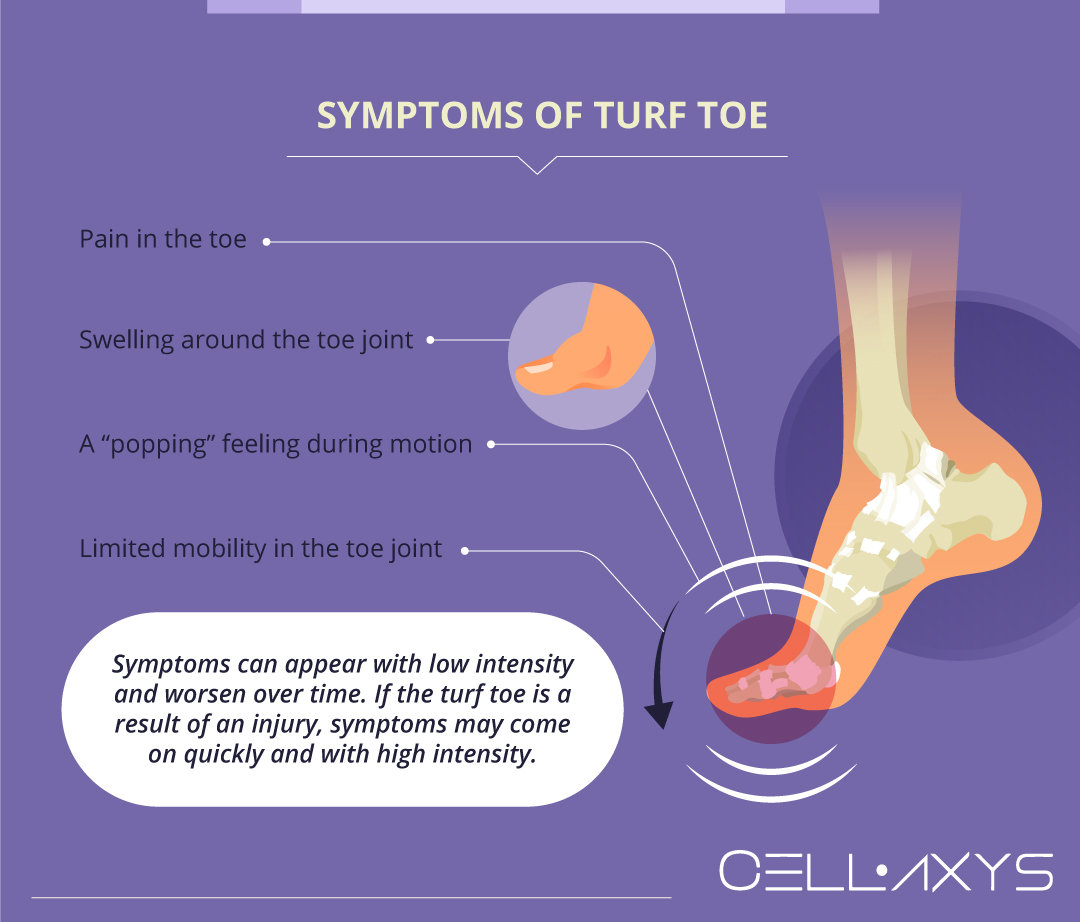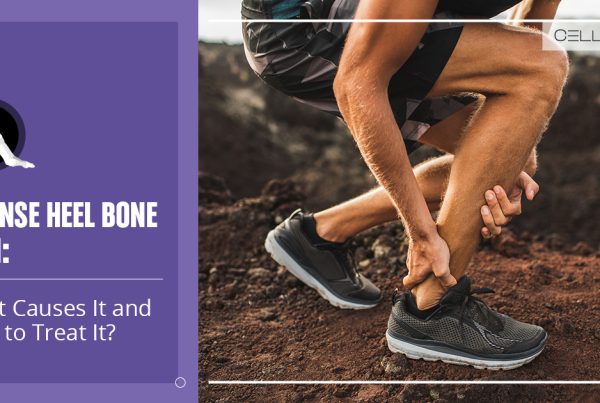Published on: October 21, 2019 | Updated on: August 29, 2024
Athletes who play contact sports, especially on harder surfaces such as turf, are prone to many injuries as the body is constantly under stress. A common injury for this type of athlete is called turf toe.
Turf toe is a result of the toe joint being placed under stress and often translates into issues with the joints and ligaments of the big toe.
Anatomy of the Toe
The big toe consists of two joints, the metatarsophalangeal (MTP) joint at the base of the toe and the interphalangeal (IP) joint in the toe. The MTP connects foot bones to the proximal phalanx, the first bone of the big toe. The IP joint connects the proximal phalanx to the distal phalanx, the bone at the end of the toe.
Ligaments are a tough form of soft tissue that serves the function of connecting bone to bone or holding joints together. Turf toe is an umbrella term for the general dysfunction of the ligaments or joints in the big toe.
Ligaments can become strained or snap. This can cause the joint structure to change in a way that causes pain.
Symptoms of Turf Toe

The main symptoms of turf toe are:
- Pain in the toe
- Swelling around the toe joint
- A “popping” feeling during motion
- Limited mobility in the toe joint
Symptoms can appear with low intensity and worsen over time. If the turf toe is a result of an injury, symptoms may come on quickly and with high intensity.
Risks and Causes of Turf Toe
Turf toe gets its name because the population who is at the greatest risk of developing it are athletes of contact sports, which generally involve artificial turf. The risk is not limited to turf sports, however. Any athlete playing on a hard surface could be at risk.
Some of the sports which put athletes at greater risk are football, lacrosse, and soccer. Other athletes are also at risk, such as dancers and runners. Some non-athletes may also be at risk.
Many cases of turf toe are also linked to athletes who wear shoes that provide little support. Shoes that are capable of bending with the foot can also allow the foot to bend in such a way that it may snap the ligaments inside.
These types of athletes are at greater risk because one of the main causes of this condition is repetitive stress to the toe. The condition can also be caused by an injury that causes the ligaments to snap.
Diagnosing Turf Toe
Once an injury has occurred, or once symptoms become difficult to manage or interfere with daily life, it is recommended to meet with a doctor. Once the evaluation begins, doctors will ask questions about activity level, family history and personal history, medical history, and shoe preference.
The goal of these questions is to conclude what the cause of pain is. Doctors will also examine the foot, looking for swelling, and testing the toe’s ability to bend.
Some doctors can come to a diagnosis with evaluation alone, but many will order certain imaging tests to ensure that the diagnosis is correct. These may include:
- X-ray: this imaging test provides an image of the bone structure in the foot, so it may be used to rule out any other structural issues which may be causing pain.
- MRI: Magnetic Resonance Imaging, or MRI, is used to gather an image of the soft tissue in the foot. This will allow doctors to see if ligaments are stressed or snapped, leading to a proper diagnosis.
- CT scan: this form of imaging can create an image of some soft tissue and bone, which allow doctors to make a diagnosis of turf toe depending on the results.
In the doctor’s office, it is important to be completely honest about where the pain is located and the severity of it. This will give doctors a clearer idea of what is causing pain.
Once doctors have made a diagnosis, they will begin to devise a treatment plan. Each treatment plan is specific to the patient based on their needs.
Treatment of Turf Toe
Many doctors will recommend rest to begin the treatment process. A common treatment of sports injuries is called the RICE method. This stands for rest, ice, compression, and elevation. All of these will help the injury to heal more quickly.
This method may be coupled with over-the-counter NSAIDs (non-steroidal anti-inflammatory drugs) such as ibuprofen or naproxen. If employing the RICE method does not do enough to relieve pain, then doctors may recommend more intensive treatment. This could include:
- Physical therapy: the goals of physical therapy are to generally improve circulation, strengthen muscles, and regain support in the injured area. Certain exercises can be done to improve an individual’s chances for a full recovery.
- Cast: some techniques that are used to immobilize the joint such as a cast or boot may be used to allow the big toe to recover. Boots may be used only during certain activities, such as walking or standing, or it may be recommended that the boot is on all the time.
- Relieving pressure: along with resting the injured area as much as possible, some doctors may suggest that the foot be unused. This often comes in the form of crutches or other walking aids that would allow the foot to be under significantly less pressure.
- Supportive shoes: many doctors will also recommend that patients wear shoes that do not allow the toe to bend, especially when the patient returns to athletic activities.
- Taping toes: some doctors will recommend that the big toe be taped to other toes so that some of the pressure is taken off of the big toe joint.
- Surgery: in extreme cases, surgery may be necessary. It is not often necessary to treat turf toe, but if there are more than one underlying issues it may be beneficial to patients. Different surgical techniques may be employed and will vary based on the severity of the injury. Surgery is almost always elective, meaning it is the patient’s decision. Surgery comes with a set of risks that may vary slightly depending on the surgical procedure. The most common risks are complications with anesthesia, infection, and stroke. It is important to maintain a line of communication with surgeons to be as informed as possible. The main goals of surgery are to repair damaged tissue or remove/replace aspects of the joint which may be causing pain.
Each treatment will be recommended based on the patient’s needs and the severity of their injury.
Some individuals who are diagnosed with turf toe can get back to their normal lives after a matter of days. In more extreme cases, it may take weeks or even months to undergo the proper treatment. In the case of assistive devices such as crutches, or when wearing a boot, it may be necessary to continue for months. In the more extreme case of surgery, recovery may take up to a year.
There is an alternative form of treatment called regenerative medicine that may speed up the recovery process and allow patients to skip surgery altogether.
Regenerative Medicine and How It Can Decrease Recovery Time
Regenerative medicine and therapies are quickly gaining traction in the medical field because of the high success rate. These treatments have been particularly effective in treating injuries to soft tissue.
Turf toe is an injury to soft tissue, whether it is the ligaments that are under stress or the padding between the bones in the toe joint. Both injury locations would be likely to respond well to regenerative medicine.
CELLAXYS offers two of these types of treatment:
- Cell-based therapies. Also known as stem cell therapies, cell-based therapies involve extracting healthy cells or “autologous” tissues from the patient’s own body. These cells are then processed so that they are more concentrated. They are then injected into the injury sites for speedy healing. Cell-based therapies typically harvest cells from adipose (fat) tissue, the process is called Minimally Manipulated Adipose Tissue (MMAT) transplant, and bone marrow, the process is known as Bone Marrow Concentrate (BMAC).
- Platelet-rich plasma (PRP) therapy. This therapy involves the isolation of platelets from the blood plasma to make them concentrated. These platelets are then injected into the patient’s injury site. Platelets are healing components, consisting of 10 Growth Factors that stimulate healing. They also give chemical signals to attract healthy cells in the blood and produce a sticky, web-like structure called fibrin. A high number of platelets in the injury site indicates speedy recovery.
Both forms of therapy are outpatient procedures, meaning you can go home right after the procedure. Both cell-based therapies, MMAT and BMAC, usually take 1.5 to 2 hours to complete. On the other hand, PRP takes around 45 minutes from start to finish.
Doctors use imaging techniques such as ultrasound to ensure that the needle is inserted into the correct spot. The patient remains under anesthesia during the procedure.
Reported side effects include pain around the injection site, which typically goes away in a day or two. The risk of rejection is very low, as it uses a patient’s own cells, and there is a minimal risk of infection.
Sources
Footnotes
- Seow D, Yusof TN, Yasui Y, Shimozono Y, Kennedy JG. Treatment options for turf toe: a systematic review. The Journal of Foot and Ankle Surgery. 2020;59(1):112-6.
- McCormick JJ, Anderson RB. Turf toe: anatomy, diagnosis, and treatment. Sports Health. 2010;2(6):487-94.
- Chinn L, Hertel J. Rehabilitation of ankle and foot injuries in athletes. Clinics in sports medicine. 2010;29(1):157-67.
- Chambers MC, Boakye L, McDowell AR, Jones SM, Yan AY, Hogan MV. Special Consideration and Perioperative Management for Turf Toe Injuries. Sports Injuries of the Foot and Ankle: A Focus on Advanced Surgical Techniques. 2019:273-9.
- Anderson RB, Hunt KJ, McCormick JJ. Management of common sports-related injuries about the foot and ankle. JAAOS-Journal of the American Academy of Orthopaedic Surgeons. 2010;18(9):546-56.
References
- Turf Toe. Mass General Brigham. Accessed 2/25/2024.
- Everything You Should Know About Turf Toe. Healthline. Accessed 2/25/2024.
- Turf Toe Treatment. SPORTS-Health. Accessed 2/25/2024.
CELLAXYS does not offer Stem Cell Therapy as a cure for any medical condition. No statements or treatments presented by Cellaxys have been evaluated or approved by the Food and Drug Administration (FDA). This site contains no medical advice. All statements and opinions are provided for educational and informational purposes only.
Dr Pouya Mohajer
Author
Pouya Mohajer, M.D. is the Director of Spine and Interventional Medicine for CELLAXYS: Age, Regenerative, and Interventional Medicine Centers. He has over 20 years of experience in pain management, perioperative medicine, and anesthesiology. Dr. Mohajer founded and is the Medical Director of Southern Nevada Pain Specialists and PRIMMED Clinics. He has dedicated his career to surgical innovation and scientific advancement. More about the doctor on this page.
Dr Pejman Bady
Contributor
Dr. Pejman Bady began his career over 20 years ago in Family/Emergency Medicine, working in fast-paced emergency departments in Nevada and Kansas. He has served the people of Las Vegas as a physician for over two decades. Throughout this time, he has been met with much acclaim and is now the head of Emergency Medical Services in Nye County, Nevada. More about the doctor on this page.









